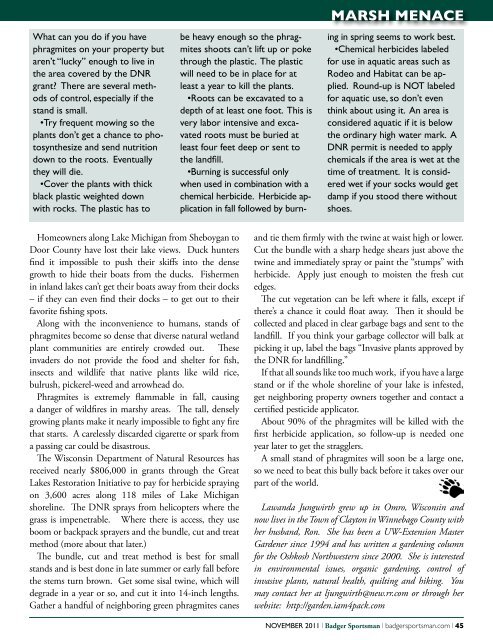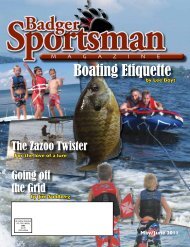Badger Deer Camp - Badger Sportsman Magazine
Badger Deer Camp - Badger Sportsman Magazine
Badger Deer Camp - Badger Sportsman Magazine
Create successful ePaper yourself
Turn your PDF publications into a flip-book with our unique Google optimized e-Paper software.
What can you do if you have<br />
phragmites on your property but<br />
aren’t “lucky” enough to live in<br />
the area covered by the DNR<br />
grant? There are several methods<br />
of control, especially if the<br />
stand is small.<br />
•Try frequent mowing so the<br />
plants don’t get a chance to photosynthesize<br />
and send nutrition<br />
down to the roots. Eventually<br />
they will die.<br />
•Cover the plants with thick<br />
black plastic weighted down<br />
with rocks. The plastic has to<br />
MARSH MENACE<br />
be heavy enough so the phragmites<br />
shoots can’t lift up or poke<br />
through the plastic. The plastic<br />
will need to be in place for at<br />
least a year to kill the plants.<br />
•Roots can be excavated to a<br />
depth of at least one foot. This is<br />
very labor intensive and excavated<br />
roots must be buried at<br />
least four feet deep or sent to<br />
the landfill.<br />
•Burning is successful only<br />
when used in combination with a<br />
chemical herbicide. Herbicide application<br />
in fall followed by burning<br />
in spring seems to work best.<br />
•Chemical herbicides labeled<br />
for use in aquatic areas such as<br />
Rodeo and Habitat can be applied.<br />
Round-up is NOT labeled<br />
for aquatic use, so don’t even<br />
think about using it. An area is<br />
considered aquatic if it is below<br />
the ordinary high water mark. A<br />
DNR permit is needed to apply<br />
chemicals if the area is wet at the<br />
time of treatment. It is considered<br />
wet if your socks would get<br />
damp if you stood there without<br />
shoes.<br />
Homeowners along Lake Michigan from Sheboygan to<br />
Door County have lost their lake views. Duck hunters<br />
find it impossible to push their skiffs into the dense<br />
growth to hide their boats from the ducks. Fishermen<br />
in inland lakes can’t get their boats away from their docks<br />
– if they can even find their docks – to get out to their<br />
favorite fishing spots.<br />
Along with the inconvenience to humans, stands of<br />
phragmites become so dense that diverse natural wetland<br />
plant communities are entirely crowded out. These<br />
invaders do not provide the food and shelter for fish,<br />
insects and wildlife that native plants like wild rice,<br />
bulrush, pickerel-weed and arrowhead do.<br />
Phragmites is extremely flammable in fall, causing<br />
a danger of wildfires in marshy areas. The tall, densely<br />
growing plants make it nearly impossible to fight any fire<br />
that starts. A carelessly discarded cigarette or spark from<br />
a passing car could be disastrous.<br />
The Wisconsin Department of Natural Resources has<br />
received nearly $806,000 in grants through the Great<br />
Lakes Restoration Initiative to pay for herbicide spraying<br />
on 3,600 acres along 118 miles of Lake Michigan<br />
shoreline. The DNR sprays from helicopters where the<br />
grass is impenetrable. Where there is access, they use<br />
boom or backpack sprayers and the bundle, cut and treat<br />
method (more about that later.)<br />
The bundle, cut and treat method is best for small<br />
stands and is best done in late summer or early fall before<br />
the stems turn brown. Get some sisal twine, which will<br />
degrade in a year or so, and cut it into 14-inch lengths.<br />
Gather a handful of neighboring green phragmites canes<br />
and tie them firmly with the twine at waist high or lower.<br />
Cut the bundle with a sharp hedge shears just above the<br />
twine and immediately spray or paint the “stumps” with<br />
herbicide. Apply just enough to moisten the fresh cut<br />
edges.<br />
The cut vegetation can be left where it falls, except if<br />
there’s a chance it could float away. Then it should be<br />
collected and placed in clear garbage bags and sent to the<br />
landfill. If you think your garbage collector will balk at<br />
picking it up, label the bags “Invasive plants approved by<br />
the DNR for landfilling.”<br />
If that all sounds like too much work, if you have a large<br />
stand or if the whole shoreline of your lake is infested,<br />
get neighboring property owners together and contact a<br />
certified pesticide applicator.<br />
About 90% of the phragmites will be killed with the<br />
first herbicide application, so follow-up is needed one<br />
year later to get the stragglers.<br />
A small stand of phragmites will soon be a large one,<br />
so we need to beat this bully back before it takes over our<br />
part of the world.<br />
Lawanda Jungwirth grew up in Omro, Wisconsin and<br />
now lives in the Town of Clayton in Winnebago County with<br />
her husband, Ron. She has been a UW-Extension Master<br />
Gardener since 1994 and has written a gardening column<br />
for the Oshkosh Northwestern since 2000. She is interested<br />
in environmental issues, organic gardening, control of<br />
invasive plants, natural health, quilting and hiking. You<br />
may contact her at ljungwirth@new.rr.com or through her<br />
website: http://garden.iam4pack.com<br />
NOVEMBER 2011 ❘ <strong>Badger</strong> <strong>Sportsman</strong> ❘ badgersportsman.com ❘ 45




